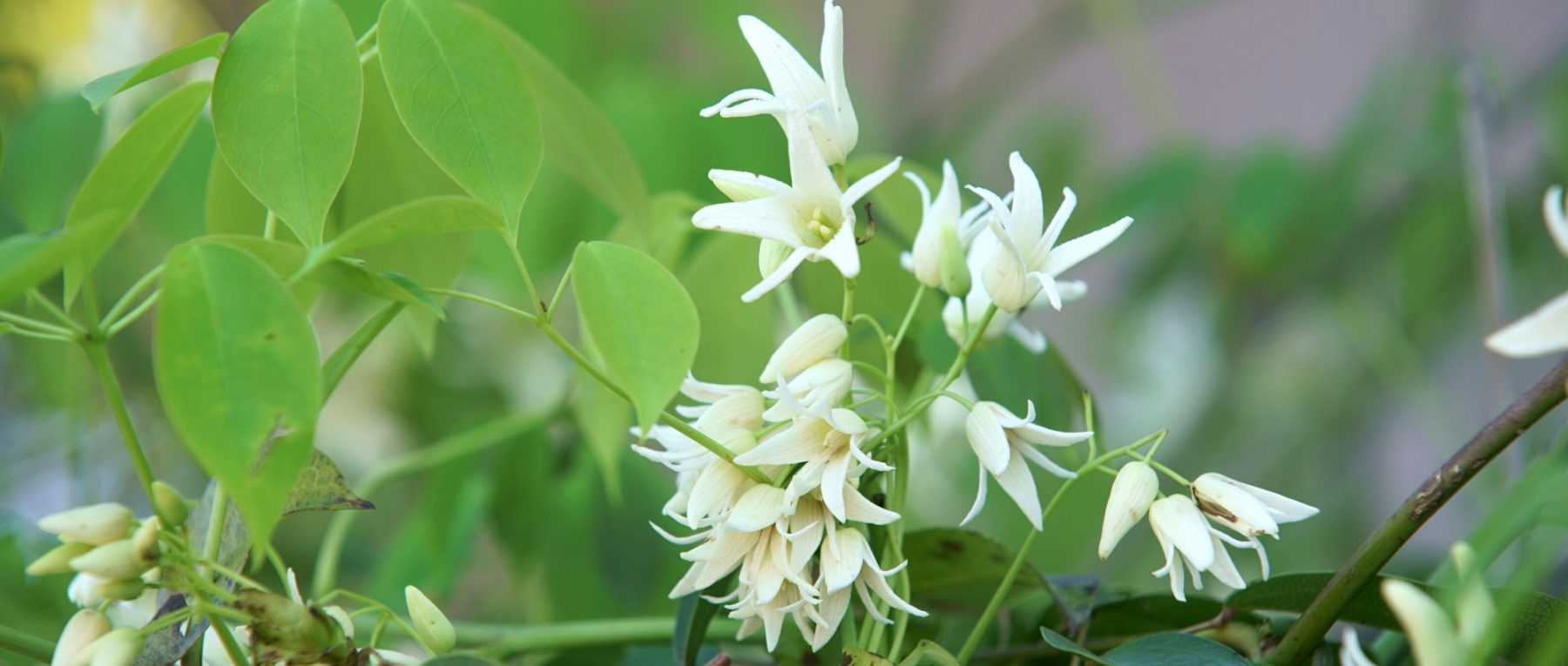
The Stauntonia: Planting, Growing and Caring for Your young plant
Contents
The Stauntonia in a few words
- Stauntonia is a vigorous, evergreen climbing plant, decorative all year round
- Its beautiful dark green, palmate and glossy foliage is particularly appealing
- In spring, it produces small bell-shaped flowers, often pale pink, light yellow or purple, with a pleasant fragrance
- It thrives in shade, in fresh, non-calcareous soil, but also adapts well to container cultivation
- It can climb pergolas, arbours, fences and trees
- This is a robust plant requiring little attention once established
Our expert's word
Stauntonias are beautiful, vigorous evergreen climbing plants native to the forests of East Asia. They produce voluble stems that twine around their support, bearing lush, beautifully divided palmate foliage. Their spring flowering is also appreciated, taking the form of delicate little bell-shaped flowers in white with purple hues (Stauntonia hexaphylla) or deep purple (Stauntonia purpurea). They remain little known and are therefore rarely cultivated in French gardens.
Stauntonias thrive in shade or partial shade, in good garden soil that is neither too dry nor too chalky. They prefer humus-bearing, fertile, and rather acidic soils. These are vigorous plants that grow rapidly. You can train them to climb over a pergola, garden shed, tree or fence. They combine easily with other climbing plants such as clematis, honeysuckles, and akebias, effortlessly creating a very natural scene in a shady corner of the garden. Discover all our cultivation advice in this guide.
Botany
Botanical data
- Latin name Stauntonia sp.
- Family Lardizabalaceae
- Common name Stauntonia
- Flowering April-May
- Height up to 10 m
- Exposure shade or partial shade
- Soil type moist, humus-bearing, rather acidic
- Hardiness down to – 8 °C, even - 10 °C
Stauntonias are woody, evergreen climbing plants native to East Asia (China, Japan, Korea, India, Myanmar, Taiwan, Vietnam…). They mainly grow in woodland undergrowth, as well as on forest edges and along riverbanks. There are 20 species. The most widespread in cultivation is Stauntonia hexaphylla, which produces beautiful white or pink bell-shaped flowers in spring. It can withstand temperatures as low as –8, even –10 °C.
Stauntonias belong to the Lardizabalaceae family, which includes climbing plants and bushes from temperate to subtropical regions. This family also includes Akebia, Holboellia and Decaisnea, which are also plants with beautiful ornamental qualities, but are still rarely cultivated in gardens. Stauntonia is very close to Holboellia, and these two climbing plants are sometimes confused.
Stauntonia grows quickly and forms voluble stems that twine around their support on their own. Its stems can reach up to 10 metres in length or height.
Stauntonia flowers in spring, in April-May, producing panicles of 3 to 10 small, highly fragrant bell-shaped flowers in the leaf axils. They form delicate, graceful, trailing bell-shaped flowers, measuring about 4 cm long in Stauntonia hexaphylla. They are described as campanulate because their shape resembles campanula flowers. The flowers have six well-developed sepals that closely resemble petals. They have a waxy, fleshy texture and are very fine and elongated. Generally, the flowers have no petals (more rarely, there may be six inconspicuous petals).
Stauntonia flowers have quite soft hues. Stauntonia hexaphylla produces very beautiful pinkish-white flowers, S. obovata has yellow flowers, while S. purpurea stands out with its dark purple flowers.


The flowering of Stauntonia hexaphylla, Stauntonia purpurea and Stauntonia chinensis (photos: KENPEI / Shihchuan / HQ)
Stauntonias are generally monoecious, but some species are dioecious. Stauntonia hexaphylla bears both male and female flowers on the same plant. Female flowers are less colourful, paler (greenish-white) than male flowers, and usually have slightly wider sepals. Male flowers have six stamens bearing pollen, while female flowers have three carpels.
Stauntonia has evergreen foliage, providing interest all year round. In spring, the new leaves that appear have a beautiful amber colour, later turning bluish-green with time. The leaves are palmate, divided into 3 to 9 entire-margined leaflets. They are thick, leathery and glossy. They resemble Schefflera foliage and measure between 7 and 15 cm long. The leaves are alternate, inserted one after another on the stem, and are borne on a long petiole.


The foliage of Stauntonia hexaphylla: young leaves with their beautiful amber colour, detail of mature leaves and leaf undersides (photos: igaguri_1 / KENPEI / Alpsdake)
With their luxuriant, beautifully palmate foliage, Stauntonias are decorative in the garden all year round, even when not in flower. They have the advantage of providing presence even in winter.
Once pollinated, the female flowers of Stauntonia produce sausage-shaped fruits in autumn, which closely resemble those of Akebia and Holboellia. These fruits measure between 5 and 10 cm in length and are purple in colour. They occur singly or in pairs (rarely in threes). They contain translucent white pulp and numerous brown seeds, which are released when the fruit reaches ripeness. These fruits are edible and are prized in Japan.
The main varieties of Stauntonia
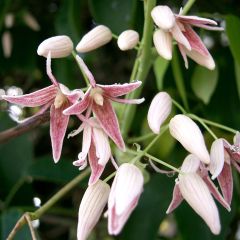
Stauntonia hexaphylla
- Flowering time May, June
- Height at maturity 10 m
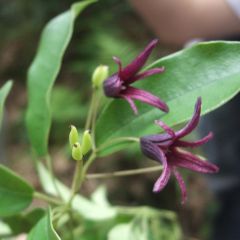
Stauntonia purpurea
- Flowering time May, June
- Height at maturity 8 m
Discover other Stauntonia
View all →Available in 1 sizes
Available in 1 sizes
Planting
Where to plant?
The Stauntonia is found growing wild in Asia in woodland undergrowth and on the edges of the forest, so it thrives in shade or partial shade. In northern France, it will tolerate a sunny position. It prefers fresh, humus-rich and rather acidic soil. It can withstand temperatures as low as -10°C, but it’s best planted in a spot sheltered from cold winds.
Plant the Stauntonia at the base of a support for climbing: this could be a pergola, arbour, garden shed, wall, fence or large tree.
The Stauntonia also adapts well to container cultivation, making it easy to bring under cover for winter. This is a good solution for growing it in colder regions as well as in chalky soils.
When to plant?
Plant the Stauntonia in spring, once the soil has warmed sufficiently and there’s no further risk of frost.
How to plant?
For planting in the ground:
- Soak the rootball in a basin of water to rehydrate it.
- Dig a planting hole two to three times the size of the rootball.
- Backfill with some soil mixed with well-rotted compost.
- Remove the Stauntonia from its pot and plant it, positioning it centrally.
- Fill around with more substrate and firm gently.
- Water generously.
- Guide the stems onto a support to help them attach.
You can also plant the Stauntonia in a large container placed on your patio and brought indoors in winter for protection from the cold.
For container planting:
- Choose a pot at least 40cm in diameter and depth.
- Place a 5cm layer of gravel or clay pebbles in the base to improve drainage.
- Add a mix of 1/3 potting compost, 1/3 garden soil and 1/3 well-rotted compost.
- Plant the Stauntonia in the pot, positioning it centrally.
- Add more compost, then firm.
- Water generously.
- You can add a thin mulch layer on the compost surface.
- Guide the branches onto their support to help them attach.
Position the pot in a shaded or partially shaded spot.
Maintenance
The Stauntonia requires little maintenance and has the advantage of being rarely affected by diseases and parasitic organisms. We recommend watering during the first year while it establishes itself and develops its root system, and subsequently during prolonged dry spells.
Similarly, it’s best to train the stems of the Stauntonia from time to time as it grows, helping them to twine around their support.
It doesn’t strictly need pruning, but you can shorten its stems if you wish to control its growth slightly. The best time to do this is after flowering.
Don’t hesitate to apply a layer of organic mulch around the base of the Stauntonia: this will help keep the soil cool for longer while suppressing weed growth.
Container cultivation:
If grown in a pot, you’ll need to stay vigilant and water occasionally, as the growing medium dries out much faster than in the ground. We recommend watering once or twice a week from spring to autumn, and applying liquid fertiliser once a month. In winter, reduce watering slightly and stop fertilising.
We also advise moving the Stauntonia into a frost-free greenhouse in autumn and bringing it back out in spring, for example to place it on your patio.
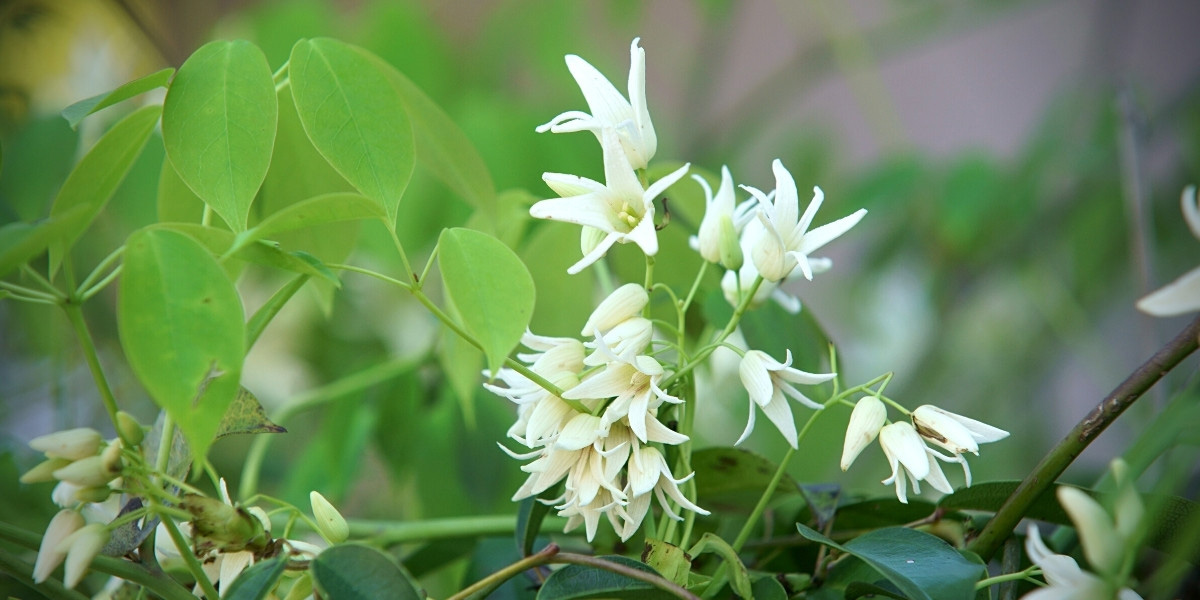
Stauntonia hexaphylla
Propagation
Sowing
Stauntonia can be propagated by sowing. The ideal method is to harvest the seeds in autumn, then place them in the refrigerator for two to three months (stratification), before sowing them.
- Start by preparing a pot with special sowing compost.
- Lightly firm and level the surface.
- Scatter the seeds over the surface.
- Cover them with a thin layer of substrate and gently firm down.
- Water with a fine spray.
- Place the pot in a sheltered spot, in bright but indirect light, ideally at a temperature between 15 and 20°C.
- Ensure the substrate remains slightly moist (but not waterlogged) until germination.
Then, be patient: the seeds may take several months to germinate. Transplant the young seedlings into individual pots once they are large enough to handle. Keep them sheltered for their first winter and wait until spring to plant them out in the ground.
Propagation by cuttings
Stauntonia can also be propagated by semi-ripe stem cuttings in summer.
- Take a stem section around 15 cm long, cutting just below a leaf.
- Remove the lower leaves, leaving only a few at the top of the cutting. This reduces evaporation and prevents the cutting from drying out.
- Optionally dip the base of the stem in plant hormone.
- Plant it in a pot filled with a mix of compost and sand, pre-moistened. The stem should be buried at least 3 or 4 cm deep.
- You can place the cutting in a humid environment by covering the pot with a cut plastic bottle or a clear plastic bag to maintain high humidity. However, open it regularly to ventilate and prevent rotting.
- Place the pot in a bright spot, out of direct sunlight.
Ensure the substrate remains slightly moist until germination.
Association
Stauntonia thrives in shady spots, making it a perfect choice for woodland gardens. Its lush foliage helps create a wild and natural atmosphere! Plant it alongside perennials with decorative and abundant leaves, such as hostas, ferns, hakonechloa, and heucheras (available in a wide variety of hues). You can also add brightness with the strikingly variegated foliage of Fatshedera lizei ‘Variegata’, a hybrid between Fatsia and ivy! For flowering companions, consider the delicate blooms of brunnera, epimediums, and Solomon’s seal.
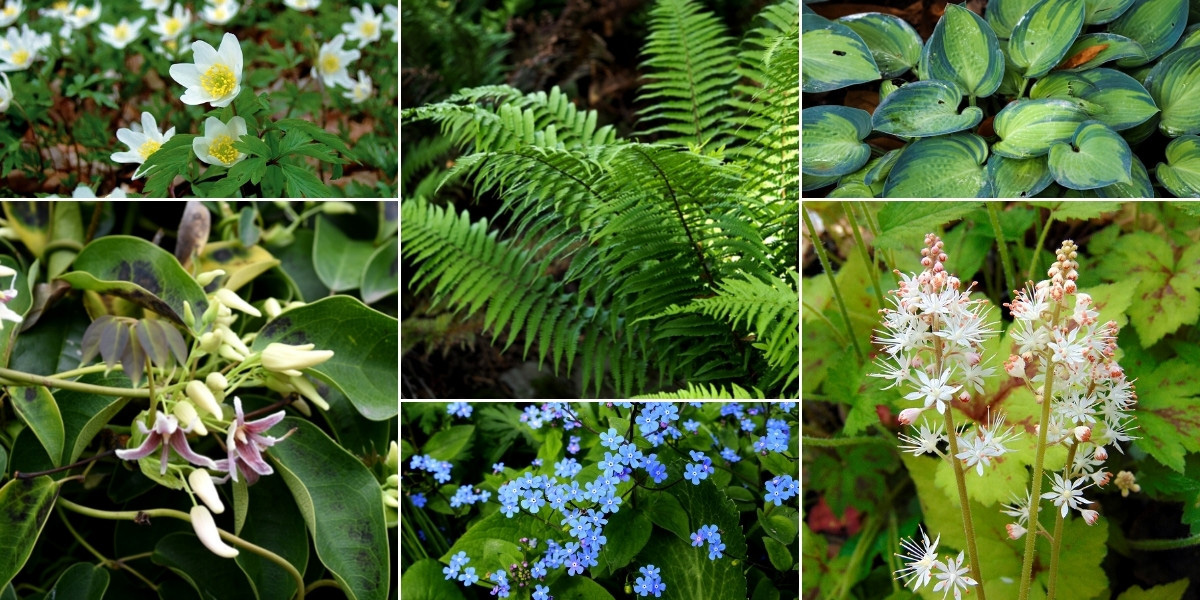
Stauntonia blends effortlessly into a woodland garden with a natural aesthetic. Anemone nemorosa (photo Pandano), Dryopteris wallichiana, Hosta ‘June’, Stauntonia hexaphylla (photo Adobe Stock), Brunnera macrophylla and Tiarella ‘Running Tiger’
As it prefers acidic soil, Stauntonia pairs beautifully with heather soil-loving bushes. Consider companions like azaleas and rhododendrons, Japanese andromeda (Pieris japonica), Daphne, Leucothoe, and Skimmia. Most of these plants also offer white or pink blooms, ideal for creating a harmonious, soft-toned border. Discover Fothergilla gardenii, which produces beautiful feathery white spikes in spring.
Don’t hesitate to combine Stauntonia with other climbing plants: Clematis montana, honeysuckle, Virginia creeper, ivy… Also consider Holboellia and Akebia, its close relatives!
Finally, it can also feature in a zen garden or Japanese-inspired setting. Create a serene, minimalist space for meditation by pairing it with the striking foliage of Japanese maples, hostas, Hakonechloa macra, Nandina domestica… Surround the garden with a bamboo border for an enclosed, intimate feel. Add ferns like Coniogramme emeiensis, Cyrtomium falcatum, or Athyrium niponicum.
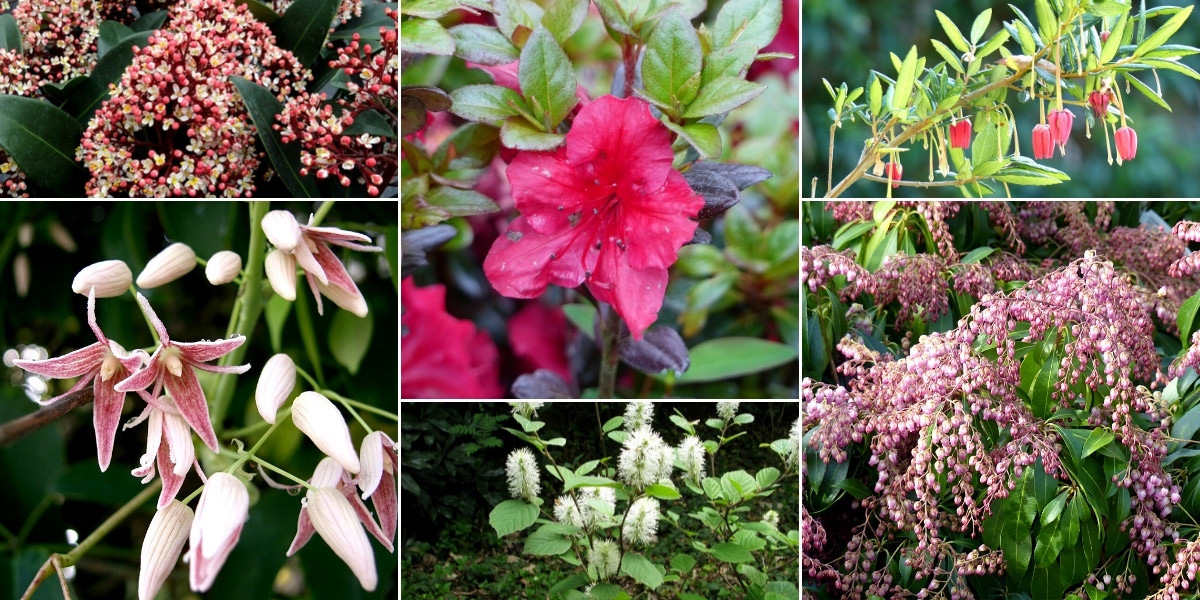
Feel free to combine Stauntonia with heather soil-loving bushes. Skimmia japonica ‘Rubella’, Japanese Azalea ‘Johanna’, Crinodendron hookerianum, Stauntonia hexaphylla (photo KENPEI), Fothergilla major (photo peganum) and Pieris japonica ‘Katsura’
→ More Stauntonia pairing ideas in our guide!
Useful resources
- Discover our range of Stauntonia
- Browse our guide on growing Stauntonia in pots
- Also discover Holboellia and Akebia, other climbing plants closely related to Stauntonia
- Subscribe!
- Contents


































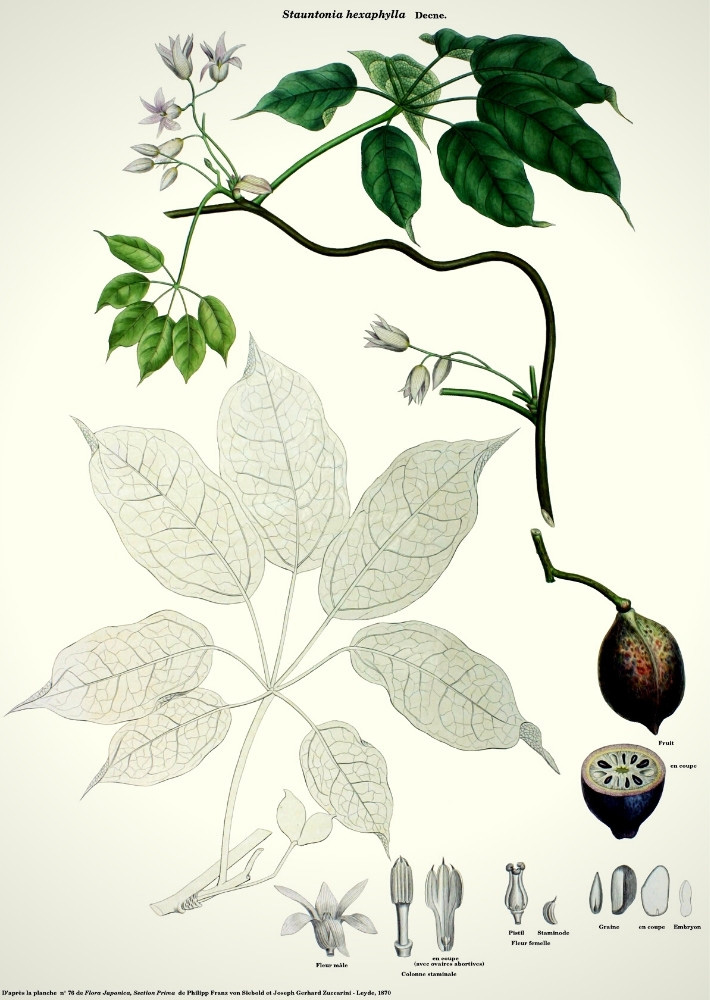
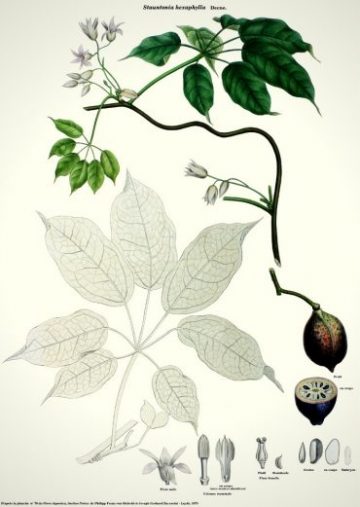



Comments